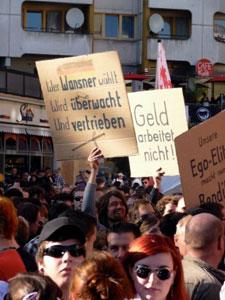Mornings in my regular life in Toronto were often fraught with indecision. Not about what to eat (often nothing) or drink (always coffee) but what to wear. As the editor of a custom beauty and fashion magazine I am required to see clients, meet with senior management and at least allude to having made an effort to dress work-appropriate. There were many days when dozens of outfits were discarded before I actually made it out the door. In the warmer months the ensemble in question needed to take me from day to evening to late into the night. My favoured mode of transportation was my beloved bicycle so the outfit needed to be comfortable, but with an air of caring and a nod to the trends of the season.
Since being abroad fashion crises have been practically nonexistent. I have limited options and although I am on the verge of setting everything I own on fire out of boredom, I can pretty much get dressed with my eyes closed.
That was until May Day. ‘Cause what does one wear that will take them from a day of music and cultural festivities to a night of rioting and setting things on fire?
In Germany the first of May is not only a national holiday, but a day of celebration — for the workers, the unions and the “people.” Unlike in Toronto where the Mayworks Festival can go largely unnoticed, May Day and the organized MyFest in Berlin is big news with big attendance and big expectations. The neighbouring areas of Kreuzberg and Neukolln are where most of the action is and on the last day of April, the shops and businesses close to the main drag of OranienStrasse prepare for the unknown. Bank and business windows are boarded up to avoid having to repair broken glass, people leave town and fingers are crossed that this year’s festivities will be less destructive than the years past.
In the weeks leading up to May Day, Megan and I began our research. Where would the events be taking place? Who did we know that would be going? How late did it go into the night? What were the chances that we would be hit in the head with a flying cobblestone? And, most importantly for me, what did people wear to avoid injury (no flip-flops since by mid-afternoon the streets and parks are filled with garbage and broken glass) and avoid being mistaken for those out to make “peaceful” trouble (no black, since it’s the unofficial uniform of the Black Bloc, the antifascist/anarchist political presence).
Having spent the morning working at home, by 4:30pm we were ready to meet up with a friend and hit the action. Our apartment, situated just inside the Neukolln border, was not far from the festivities and as we walked up to the main area we could see the beginning of the night to come. The trashcans, already overflowing onto the street, were surrounded by beer bottles (it being legal to drink in the streets, on the subway, in the park and pretty much anywhere), food remnants, plastic glasses and water bottles. The shops were boarded up and outside of almost every restaurant, café, bakery and convenience store there was a sidewalk stand selling the day’s staples — bready edible items and alcohol. Unlike at home, there were no permits required.
Closer to the street festival, just past the antifascist stage at Kotbusser Tor U-Bahn, a stand serving Red Bull and Vodka advertised its wares with a sign fashioned out of a cardboard box and a Sharpie, and throughout the crowd, enterprising individuals wound their grocery carts to collect the empties tossed away by those who couldn’t be bothered to hang onto them for the 8 centime deposit.
If you didn’t know what day of the year it was, this festival could have been for almost anything, save for the occasional anarchist flag or antifascist placard. Once on the main drag, there was nothing that really set it apart from any other celebration. There were countless bands, official stages, random groups of people dancing around musicians who had come out with their musician pals simply to entertain. Corners became makeshift stages for brass bands and Turkish folk music and the streets were the dancefloor.
By our estimation there were close to half-a-million people at the official MyFest 2009 event. And it wouldn’t be a major political happening in this town without a police presence. In years past the clash between the Black Bloc and the “establishment” — represented in live action by the Berlin police force and federal riot police — was far more volatile than in recent years. These days the police hang out, smoke cigarettes and wait for the sun to go down. They move their convoys into position wearing T-shirts and police issue pants, and generally stay out of the fray. But by dusk they are ready for anything. Bulletproof vests hide under their police issue riot gear and they continue to smoke and hang out on the edges of the action — that is until someone throws the first bottle or sets the first car on fire.
Like true Canadians, we hit the road at the first sign of rioting. Without healthcare, head wounds can be expensive and since I’ve never wanted to experience tear gas first hand, the sight of 30 riot police moving in formation toward us was our cue to head home. We left our Berliner pal behind, happily drinking a beer and ready to run. Myself, I prefer to walk.

 Why you can trust Xtra
Why you can trust Xtra


